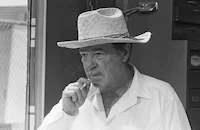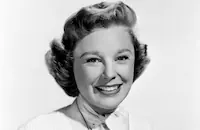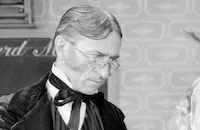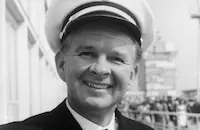The McConnell Story

Brief Synopsis
Cast & Crew
Gordon Douglas
Alan Ladd
June Allyson
James Whitmore
Frank Faylen
Robert Ellis
Film Details
Technical Specs

Synopsis
In 1941, Joseph "Mac" McConnell, Jr., a private in the Army medical corps near Fitchburg, Massachusetts, who aspires to be an airplane pilot, hopes the Army will send him to flight school. Mac goes AWOL to take private piloting lessons, but while flying with his instructor, he realizes that military police are waiting for him at the airport. To avoid arrest, he parachutes out of the plane and then hitches a ride with teenager Bob Brown. After eluding Mac's pursuers, Bob takes him to his home in Fitchburg, where he introduces Mac to his mother, young brother and sister Pearl, whom Mac nicknames "Butch." When the military police track Mac to the house, Mac hastily exits through a back window and returns to the base, where his superior, Sgt. Sykes, sentences him to the stockade. Wanting to see Butch again, Mac sneaks out and returns to the Brown home and later, after a brief courtship, proposes to her at a boxing match. Sykes is reluctant to give the irresponsible Mac permission to marry, until he meets Butch and realizes that she will be a stabilizing influence on him. Trying to help the young couple, Sykes arranges for Mac's promotion and transfer to a medical school in Texas, but the transfer order comes through on the McConnells' wedding day, thus preempting their honeymoon. The couple moves to an inexpensive apartment near the Army base, but Mac and his teachers soon agree that he belongs in flight school. When he is transferred to Washington state, Butch, who is pregnant, returns to Fitchburg. During his leave at Christmastime, Mac tries to hitchhike across country, but he runs out of time halfway there and has to return without seeing her. When he arrives at the base late, he is punished with sentry tour. Forbidden to contact Butch, Mac learns about his daughter's birth from friend and fellow student, Ty Whitman. After completing school, Ty is chosen to be a pilot, but the disappointed Mac is assigned to be a navigator. Later, while fighting the Nazis over France, Mac and his crewman on a B-17 aircraft are attacked by a new German jet plane and after crash landing, are rescued. After World War II, Mac, trying to forget his dream of flying, is miserable at his desk job in Nebraska. When Ty tells him about the Army's recruitment of experienced fliers for a new jet corps, he volunteers. Reluctantly agreeing with Ty that Mac was "born to fly," Butch supports Mac's decision, but fears for his safety. After training, Mac makes his first solo flight on one of the new jet planes, while Ty, radioing from the ground, talks him through the terrifying experience of flying at supersonic speed. Mac is transferred from base to base with his family, which eventually includes another daughter and son. Before he is sent to fight in the Korean War, Mac takes Butch on a picnic in Apple Valley, California, where he has bought property. While he tells Butch of his plans to build a house there when he returns, planes passing overhead fly in the "missing man formation" and Mac explains that the pilots are honoring a colleague who was killed. In Korea, Mac helps to rescue men on a downed aircraft in the middle of enemy territory. During another mission, his plane is shot down over the sea and he must parachute to safety. Mac distinguishes himself by gunning down enemy aircraft, which are called MiGs, setting a record for the most hits. After downing 15 MiGs, he is named the first triple jet ace in history, but after shooting down his 16th, Ty and his superiors fear that he is getting tired and reckless and transfer him stateside to train new pilots. In the States, he is given a hero's welcome and meets the president. When he and Butch return to Apple Valley, their neighbors, who are proud that the hero has chosen to live in the area, present the family with the keys to a house that was specially built for them. After they settle in, Ty, who is now a colonel, asks Mac to take a job testing new jets. Mac is eager, but Butch, concerned about his safety, demands that he refuse the offer. However, she changes her mind, and Mac begins testing the new F86h. Mac flies the plane faster and faster, despite Ty's warning to slow down. When Mac reports that the controls on the plane have frozen, Ty radios Mac to bail out. Mac, believing that he can regain control, stays aboard and perishes when the plane crashes. Ty immediately goes to the McConnell home to tell Butch about Mac's death, but seeing planes in the missing man formation overhead, she has already realized what happened. Months later, Ty takes the bitter and still-grieving Butch to the base. As they watch the new test pilot check out modifications prompted by Mac's accident, Ty says that Mac's death will save the lives of many men, and Butch agrees that nothing about Mac was wasted.

Director

Gordon Douglas
Cast

Alan Ladd

June Allyson

James Whitmore
Frank Faylen
Robert Ellis

Willis Bouchey
Sarah Selby

Gregory Walcott

Frank Ferguson

Perry Lopez
John Pickard
Dabbs Greer
William Leicester
James Cornell
Donald Kerr

Edward Platt
Vera Marshe
Dub Taylor
Herb Vigran
Grandon Rhodes
George Selk
Murray Alper

Lillian Bronson

John Alvin

Gene Reynolds
John Beradino
Gayle Kellogg
John Mckee
Sam Edwards
Baynes Barron
Ken Patterson
Billy Mclean
Frank Gerstle

Olin Howlin
John Larch
Laura Elliott

James Dobson

Tito Vuolo
Grazia Narciso
Paul Baxley
Harley Forbes
Willard Willingham
Michael Keith
Sammy Armaro
John Veitch
Ralph Barbe
Brad Harris
Jack Semple
Harry Harvey Jr.
Richard Binder
Richard Brehm
Arvo Ojala
John M. Reed
Donald Robinson
Fred Stromsoe Jr.
Bob Taylor
Alan Craige
Ronald Bischof
Robert Brucewood
Tony Randall
Jim Meservie
Norman Papson
William Graeff Jr.
William H. Hudson
Jack Downs
Gene Ardell
Paul Kennedy
Dorothy Heller
John Bogden
Gloria Marshall
Bert Rose
Allen Zeidman
Joe Brooks
Alice Marr
Ann Cameron
Pat Blake
Linda Vrana
Susan Odin
Ray Ferrell
Carol Sydes
Cindy Lee
Debby Sydes
Andrea Lee
Kathy Sanders
Alano Jo Como
Louie Towers
Kenneth Finger
Crew
Gordon Bau
John Beckman
Henry Blanke
Leon Charles
Murray Cutter
Manuel "pete" Fernandez Capt. Usaf
Chuck Hansen
William Kissel
William L. Kuehl
Charles B. Lang
Owen Marks
Ted Mccord
William L. Orris Col. Usaf
Sam Rolfe
Russ Saunders
John Seitz
Ted Sherdeman
Ted Sherdeman
Howard Shoup
Max Steiner

Videos
Movie Clip



Trailer
Film Details
Technical Specs

Articles
The McConnell Story
Mac and Butch marry, but their honeymoon is interrupted before it begins when the army transfers the reluctant private to a medical school in Texas. Medical school is not the best choice for McConnell, who is born to fly, so they transfer him to flight school. Mac is assigned to be a navigator and finishes the war fighting Nazis in Europe. A desk job in Nebraska after WWII proves less than satisfying, so when buddy Ty Whitman lets him know that the army is seeking experienced pilots for a new air corps, Mac volunteers to fly the new jet planes. War breaks out in Korea, and Mac signs up as a fighter pilot, becoming one of the army's two top flying aces. By 1953, he had gunned down 16 enemy aircraft, which were called MiGs, including three in one day. The latter feat made him the army's first triple ace. Mac is transferred back to the States to train new pilots. While testing the new F86h, the plane's controls freeze, and Mac dies when the aircraft crashes. His accident prompts modifications in the F86h, and Butch and Ty are comforted by the knowledge that his death will save the lives of future pilots.
In general, the Hollywood studios found the Korean War a less-than ideal subject, because the causes and issues of the war were ambiguous. Never officially declared a war, the event was termed a conflict or a police action with no clear-cut objective to be obtained or enemy to be defeated. Instead, the goal was for a negotiated settlement, which was not conducive to rousing drama. When the Korean War began, Hollywood rushed a couple of properties into production, falling back on the conventions of the World War II film. Samuel Fuller's The Steel Helmet (1951) was the first film about Korea to be released, but its low-budget look and familiar clichés undermined the gritty drama of the story. As the war continued, and the lack of clarity regarding the conflict became more apparent, movies about Korea, such as Retreat, Hell (1952) and The Bridges at Toko-Ri (1954), grew more pessimistic. After the Panmunjom truce was signed in July 1953, and the situation ended in a frustrating stalemate, most of the studios lost interest in the Korean Conflict as a subject matter.
The life of Joseph C. McConnell gave Warner Bros. an opportunity to tell the story of a real-life bona fide hero, focusing on his reputation and accomplishments rather than the details of a vague conflict in an ever-confusing international political scene. McConnell and his fellow jet-fighter pilots, including the other premiere ace, Manuel Fernandez, were the only positive news from the war. These pilots still engaged one-on-one with the enemy in the air, firing aerial machine guns at each other. Within a few years, this mode of air combat would be replaced by guided missiles or other types of sophisticated instrumentation. The film was in pre-production when the real Mac McConnell was killed in a plane crash while testing a new type of jet for the air force. The tragedy turned the film into an epitaph for McConnell and a tribute to the other fighter pilots. The McConnell Story serves as a memorial to a small part of history that might otherwise have been lost after the Korean Conflict faded from the collective consciousness of the public.
Alan Ladd plays the title character with his trademark stoicism--the kind of cool demeanor that had made him so poignant in Shane (1953). However, Mac McConnell was something of a colorful rebel, at least as depicted in the film, and his determination and defiance needed a more volatile portrayal than Ladd could muster. Ladd was experiencing a turning point in his life and career during the mid-1950s. He had left Paramount in the early 1950s and signed a three-film deal with producers Albert Broccoli and Irwin Allen and their independent production company, Warwick Films. In 1954, Ladd followed the example of other major stars and formed his own production company, Jaguar Films. Personal problems plagued Ladd throughout most of his life, including depression. According to his autobiography, his depression intensified after his affair with costar June Allyson ended the year The McConnell Story was released. The rest of Ladd's career was defined by a handful of good films interspersed among a string of mediocre titles.
By the time June Allyson was cast as Butch McConnell, her star image as the ideal 1950s wife was firmly established. Dependable and doting, her characters waited sweetly, anxiously, or endlessly for her husband to come home, settle down, or change his ways. Previously, in The Stratton Story (1949), The Glenn Miller Story (1954), Executive Suite (1954), Woman's World (1954), and Strategic Air Command (1955), she had supported her husband's ambitions, worried about his welfare, dutifully took care of the home, and rarely chased after any goals, dreams, or opportunities of her own. So entrenched was her star image that the review of The McConnell Story in The New York Times noted, "And June Allyson, as his true-blue and uncomplaining spouse, should be accustomed to this type of film assignment by now."
While Allyson's character may seem hopelessly dated to contemporary viewers, she was nonetheless a movie star who was charismatic and professional. Allyson's spunk and charm added a charged energy to her scenes with the laconic Ladd and a light-heartedness to a film weighed down with serious male characters and their death-defying deeds.
By Susan Doll
Producer: Henry Blanke for Warner Bros.
Director: Gordon Douglas
Screenplay: Ted Sherdeman and Sam Rolfe from a story by Ted Sherdeman
Cinematography: John F. Seitz and Ted D. McCord
Editor: Owen Marks
Art Director: John Beckman
Costume Designer: Howard Shoup
Music: Max Steiner
Cast: Joseph C. "Mac" McConnell (Alan Ladd), Pearl "Butch" McConnell (June Allyson), Ty Whitman (James Whitmore), Sergeant Sykes (Frank Faylen), Bob Brown (Robert Ellis), Newton Bass (Willis Bouchey), Mom Brown (Sarah Selby), Military Policeman (Gregory Walcott), Mechanic (Frank Ferguson), Red (Perry Lopez), Pilot Instructor (Dabbs Greer), Medical Captain (Edward Platt), Technical Sergeant (Dub Taylor)
1955 Color 107 mins.

The McConnell Story
Quotes
Trivia
Notes
Gen. Otto P. Weyland, Chief of the Tactical Air Command, U.S.A.F., appears after the opening credits, and dedicates the film to the men of the United States Air Force. The following written acknowledgment appears after the film: "To the 366th Fighter Bomber Wing, to the 479th Fighter Day Wing, to the Tactical Air Command and all units of the United States Air Force, both active and reserve, without whose assistance this picture would not have been possible-grateful appreciation."
As depicted in the film, the real Joseph C. McConnell, Jr. (1922-1954) began flying in World War II as a navigator on B-24 airplanes. After achieving pilot status, he pushed for an assignment as a jet fighter pilot in the Korean War, although he was considered, at 28, too old by the Air Force. Flying Sabre F-86 jets, McConnell battled with Soviet-developed airplanes called MiG-15s. Although he experienced several close encounters with death, as the film showed, McConnell remained unharmed and downed a record-breaking total of sixteen MiGs. In one day, he downed three MiGs, which made him the first "triple ace" pilot of the Korean War. Following this, Air Force officials, not wanting to further risk their best pilot, ordered him to return immediately to the United States and he was assigned to train other pilots.
A September 1955 Los Angeles Examiner reported that when McConnell returned from the war in 1953, his Apple Valley neighbors presented him with a $16,000 "Appreciation House," an event that was also depicted in the film. Approximately one year later, McConnell died in a crash near Edwards Air Force Base in the Mojave Desert when the hydraulics failed on the F-86h he was testing. As shown in the film, he tried to land the plane using throttle and rudder, a technique he had used successfully in Korea, but ground turbulence intervened. As a last resort, he ejected from the plane, but was, by then, too close to the ground to survive. According to a September 1955 Los Angeles Times news item, his death on August 25, 1954 occurred while The McConnell Story was in preparation, causing a new, tragic finale to be added to the screenplay. A September 1955 Los Angeles Examiner article reported that the Air Force later announced that the crash was caused by the failure of ground mechanics to secure a nut and bolt on the craft's stabilizer.
A December 1954 Hollywood Reporter news item adds William Lester to the cast, but his appearance in the released film has not been confirmed. Hollywood Reporter news items and an August 1955 Los Angeles Daily News article reported that portions of the film were shot in the following locations, many of them identified in the film: Apple Valley, CA; Ft. Devins, MA; Orange County Air Field, Santa Ana, CA; the air fields at Lockheed Aircraft Company, Burbank, CA, and Pullman, WA; Grand Central Terminal, Glendale, CA; Dow Field, Bangor, ME; Elmendorf Field, Anchorage, AK; and the following Air Force Bases: Edwards AFB, Palmdale, CA; George AFB, Victorville, CA; Hamilton AFB, DeWitt, CA; Williams AFB, Chandler, AZ; and Randolph Field and Hondo Air Force Bases in Texas. Some aerial footage was also filmed over Alexandria Air Force Base in Louisiana.

Miscellaneous Notes
Released in United States Fall September 1955
Released in United States on Video April 3, 1991
CinemaScope
Released in United States on Video April 3, 1991
Released in United States Fall September 1955














